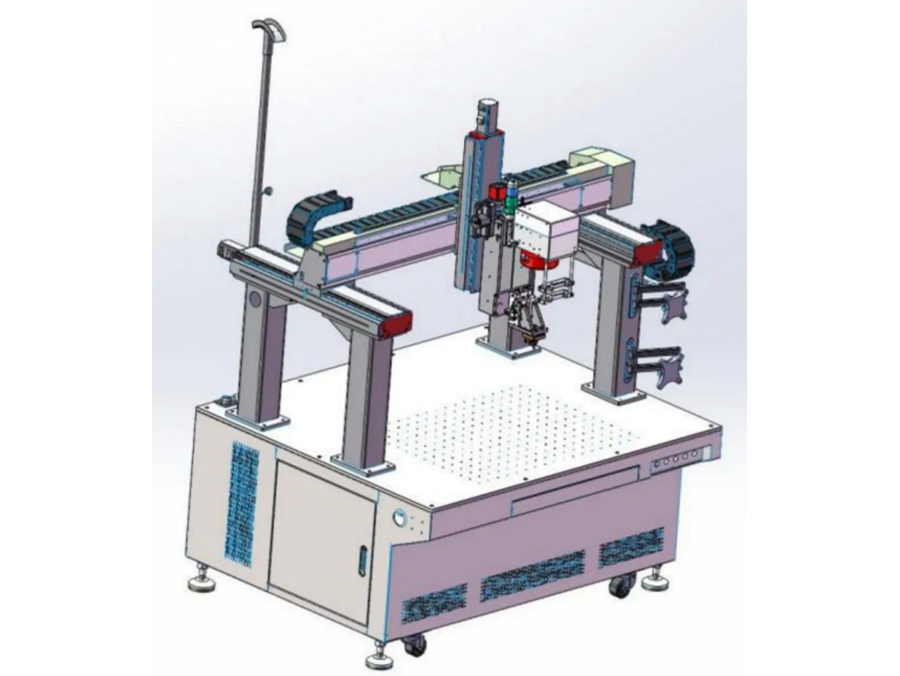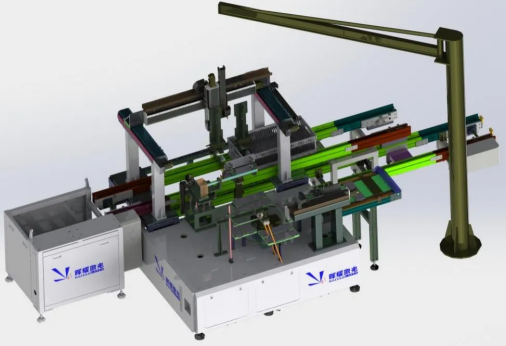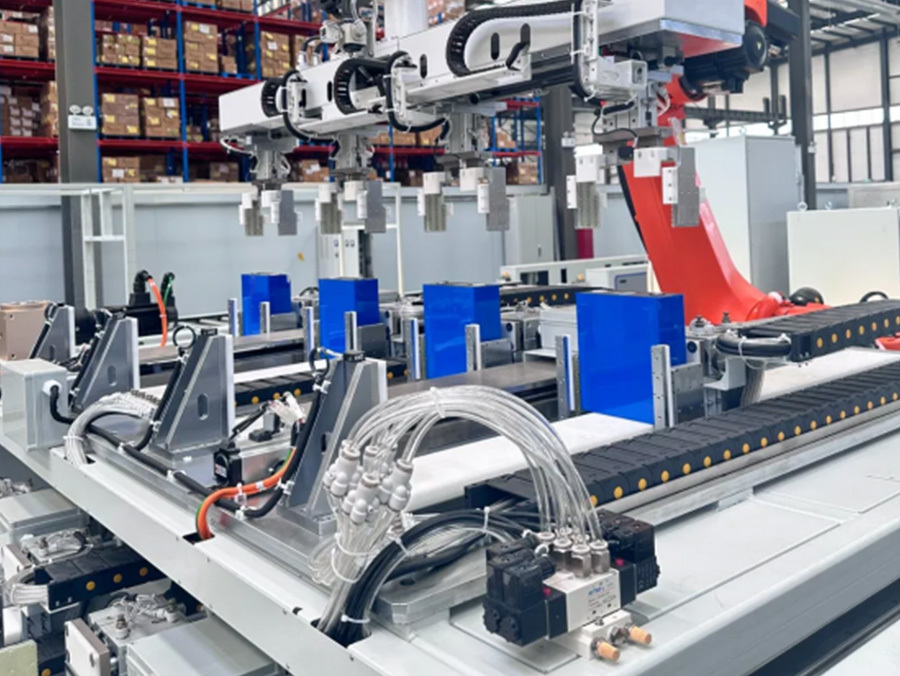Solution

EV Battery Module PACK BMS Testing System
- Product description
-
- Commodity name: EV Battery Module PACK BMS Testing System
- Commodity ID: 动力电池模组PACK BMS系统测试系统
The Battery Module PACK BMS Testing System is a precision testing platform designed to validate the functionality and performance of Battery Management Systems (BMS) integrated into battery modules and PACKs.
1. Equipment Overview
The Battery Module PACK BMS Testing System is a precision testing platform designed to validate the functionality and performance of Battery Management Systems (BMS) integrated into battery modules and PACKs. The system provides comprehensive testing, including communication protocols, balancing functionality, protection mechanisms, and performance under simulated conditions. It is essential for EV battery production, energy storage systems (ESS), and R&D applications.
2. Key Features
- Comprehensive BMS Validation: Tests communication, protection, balancing, and thermal management.
- Protocol Support: Compatible with common communication protocols (CAN, RS485, LIN, etc.).
- Simulated Environments: Emulates cell voltages, currents, and temperatures for realistic testing.
- High Precision: Accurate measurement and control of electrical parameters.
- Customizable Profiles: User-defined test scenarios for diverse application needs.
3. Technical Specifications
3.1 Electrical Testing
- Voltage Simulation Range: 0–5 V per cell (configurable for up to 32 cells in series).
- Voltage Accuracy: ±0.02%.
- Current Simulation Range: -200 A to +200 A (bidirectional).
- Current Accuracy: ±0.1%.
- Capacity Range: 10 Ah–500 Ah.
- Balancing Current Simulation: 0–5 A per cell.
3.2 Communication Protocols
- Supported Protocols: CAN, RS485, LIN, Ethernet.
- Baud Rate: Up to 1 Mbps (CAN).
- Error Detection: Monitoring of communication stability and integrity.
- Protocol Customization: Configurable for proprietary or custom protocols.
3.3 Protection Function Testing
- Overvoltage/Undervoltage Protection: Simulates threshold violations to validate BMS responses.
- Overcurrent/Short-Circuit Protection: Verifies BMS safety shutdown mechanisms.
- Thermal Protection: Tests BMS reactions to simulated temperature deviations.
3.4 Thermal Simulation
- Temperature Range: -40°C to 100°C (simulated via thermocouples or RTD interfaces).
- Temperature Accuracy: ±1°C.
- Thermal Coupling: Supports testing for thermal management system integration.
3.5 Dynamic Testing
- Load Simulation: Variable load profiles to mimic real-world conditions.
- Cycle Testing: Programmable charge-discharge cycles with real-time BMS monitoring.
- Fault Injection: Simulates failures (e.g., sensor disconnection, communication errors) to test BMS resilience.
3.6 Software and Control
- User Interface:
- 15-inch touchscreen HMI.
- Multi-language support (English, Chinese, etc.).
- Data Management:
- Real-time monitoring and graphical data visualization.
- Export formats: CSV, Excel, PDF.
- Test Programming: Flexible configuration for custom test cases.
- Remote Access: Ethernet and Wi-Fi for remote monitoring and control.
3.7 Mechanical Design
- System Configuration:
- Modular design for easy expansion.
- Fixtures adaptable to various module and PACK sizes.
- Dimensions:
- Length: 1,500–2,000 mm.
- Width: 800–1,200 mm.
- Height: 1,800–2,000 mm.
- Weight: 800–1,500 kg.
3.8 Safety Features
- Overvoltage/Overcurrent Protection: Ensures safety during operation.
- Short-Circuit Detection: Immediate shutdown in fault scenarios.
- Emergency Stop: Operator-accessible emergency shutoff.
- Environmental Monitoring: Smoke and temperature sensors for additional safety.
- Certifications: CE, UL, ISO 9001 compliant.
3.9 Environmental Requirements
- Operating Temperature: 10–35°C.
- Humidity: ≤60% RH (non-condensing).
- Power Supply: AC 380V ±10%, 50/60 Hz, 3-phase.
- Power Consumption: ≤10 kW.
4. Applications
- EV Battery Production: Ensures BMS functionality in modules and PACKs for electric vehicles.
- Energy Storage Systems (ESS): Validates BMS used in grid-scale and residential storage systems.
- Consumer Electronics: BMS testing for small devices and power tools.
- R&D and Quality Assurance: Supports development and validation of BMS designs.
5. Maintenance and Warranty
- Maintenance Schedule:
- Weekly: Inspect communication interfaces and connectors.
- Monthly: Verify voltage, current, and thermal simulation calibrations.
- Annually: Comprehensive diagnostics and software updates.
- Warranty Period:
- Standard: 12 months.
- Extended: Available upon request.
Key words:
EV Battery Module PACK BMS Testing System
Series of Products
Huiyao Laser is a leading battery laser welding machine manufacturer offering professional battery pack and battery module welding solutions for many fields, such as energy storage systems of research and development machines, as well as complete assembly lines for module and battery pack production.
Comprehensive Pouch Battery Module PACK Automatic Production Line for Efficient Output 12PPM is designed for the modular production of solid-state batteries, featuring high automation, flexibility, and integrated quality control (QC) systems. It ensures efficient production while maintaining strict quality standards. The line is suitable for electric vehicles, energy storage systems, consumer electronics, and more, supporting the production of various specifications of solid-state battery modules.
Comprehensive Pouch Battery Module PACK Automatic Production Line for Efficient Output 12PPM is designed for the modular production of solid-state batteries, featuring high automation, flexibility, and integrated quality control (QC) systems. It ensures efficient production while maintaining strict quality standards. The line is suitable for electric vehicles, energy storage systems, consumer electronics, and more, supporting the production of various specifications of solid-state battery modules.
Huiyao Laser Fully-Automated Energy Storage Prismatic Battery Module PACK Line
Huiyao Laser Energy Storage Automatic Prismatic Battery Module PACK Line is an efficient, intelligent and customized automated production line, specifically designed for the energy storage field. It is suitable for application scenarios such as large - scale energy storage systems, home energy storage, and industrial energy storage. This production line integrates advanced laser welding technology, automated assembly systems, and intelligent detection equipment, aiming to provide customers with the production of battery modules with high consistency and high reliability.
Get a Free Quote
PLEASE LEAVE YOUR MESSAGE AND WE WILL CONTACT YOU AS SOON AS WE RECEIVE IT!
FAQ
Q
How do you ensure consistent weld quality in the assembly of Prismatic battery packs?
A
Q
What are the best practices for cell alignment and stacking in a Prismatic battery PACK assembly?
A
Copyright © Huiyao Laser Technology (Luoyang) Co., Ltd. Has supported ipv6




